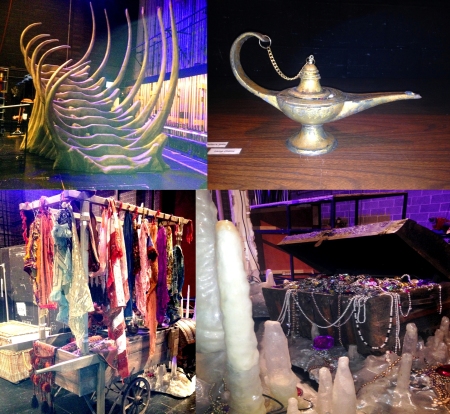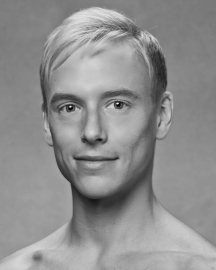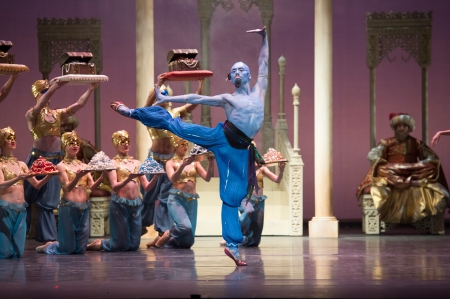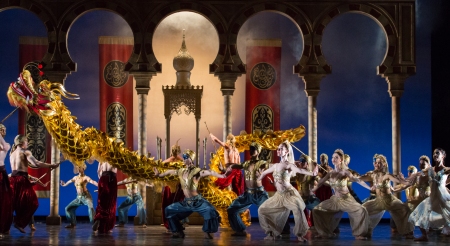 |
Christopher Gray as the Djinn (Genie) with artists of Houston Ballet; Aladdin; Photo by Amitava Sarkar
|
 |
| Behind the scenes shots by Stephanie Brown |
One of my favorite characters in Aladdin is the Djinn of the lamp (the Genie), and demi soloist Christopher Gray dances his heart out in this role. I was intrigued by his experience in creating his own version of the the Djinn of the lamp (the Genie), so we asked a few questions about the role.
Watch video of Christopher Gray as the Djinn in Aladdin.
Houston Ballet: Tell us about dancing as the Djinn of the lamp (the Genie). What are the most challenging aspects? What are the most exciting?
 |
| Christopher Gray; Photo by Amitava Sarkar |
Christopher Gray: Hands down, one of the most challenging things is that some of the magical reveals were hidden in set pieces for long periods of time before some pretty difficult dancing. So it’s the opposite of what you would normally do, which is to stay moving, keep yourself loose and then go out and dance. Being crouched down in a small space before having to dance is pretty difficult.
For the most exciting thing, this is my third time flying in ballet, and I always love doing that. The audience always really appreciates it. On opening night during the first scene with the levitation, everybody applauded. It was great! So that’s always exciting for me. It’s a challenge as well because you’re at the mercy of the wire when you’re up there. There’s not too much you can do to keep yourself from spinning or swinging, so it’s learning how to do those small adjustments without putting yourself in a counter rotation.
Houston Ballet: Explain your wardrobe. How do you feel about being painted completely blue?
Christopher Gray: Fortunately, it’s not completely blue. I don’t have to paint my legs. This in terms of ballet costumes is not so difficult to dance in, which I always like. Sometimes we have pounds and pounds of clothing and wigs we have to deal with, so this is relatively simple. [I wear] just a small vest and baggy pants
 |
| Artists of Birmingham Royal Ballet; Aladdin; Photo by Bill Cooper |
Any time you don’t feel constricted by a costume, which I don’t because there are even shirtless scenes for me, it’s a lot easier to deal with. I prefer pants over tights any day of the week! In terms of wigs, Amanda, our wig and makeup person, has done a great job of making a wig that fits really flush to our heads. We just have a little bit of hair, like a top knot pony tail, which I don’t feel impedes my ability to turn and it doesn’t knock me off center, which is often a problem with costumes.
Being painted blue is hard. I’m there around 6:15 for a 7:30 start time. And that includes not even being on stage until a good 40 minutes into the first act. Overall, I face about an hour and a half worth of body makeup, face makeup, and wigs. It’s difficult and, once again, the opposite of how you would want to get ready for a show…you know, standing there half naked for an hour and a half. I do throw warm-up clothes back on top, but you don’t want to sweat the makeup off. It’s a fine line you have to deal with. I’m getting pretty used to being painted, though. I think this is my third or fourth color!
Houston Ballet: What do you do to get in character for the the Djinn of the lamp (the Genie)?
Christopher Gray: As the body makeup and especially face makeup and wig come along, I feel like that’s part of my transformation. We have these wicked eyebrows and drag queen style makeup. So it’s hard not to look at yourself with a little bit of humor when you see the character staring back at you.
If anything, the one thing that I have been doing is going over the mime section to try to create an aura of power, confidence, mystery, and a little bit of humor as well. Trying to work the fake eyebrows has been fun. As the shows progress, you find more time and space for that on stage and then the character grows from there.
 |
| Artists of Houston Ballet; Aladdin; Photo by Amitava Sarkar |
Houston Ballet: What do you like about the props and costumes for Aladdin?
Christopher Gray: One of my favorites is probably the most simple: the lamp that lights up. I think it’s very effective on stage. Those few times Aladdin lifts it up and then there’s a big crescendo in the music when it turns on and starts glowing…I think that’s fantastic! Also, the magic carpet is done really well.
I wish I could see the show from the front, but unfortunately that’s not in the cards for me. The lion dance in the second act is a big crowd favorite, and I also dance the head portion of the lion. It’s a lot of fun to do that. It does pose a problem because it’s difficult to hear the music, though. When you start shaking the head all you hear is rattling!

